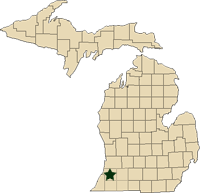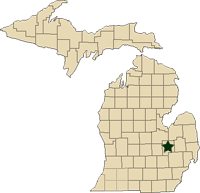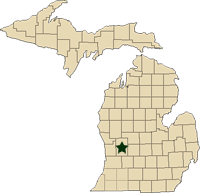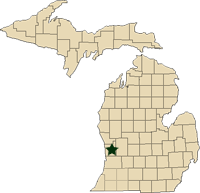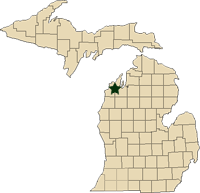Regional reports on Michigan fruit – May 22, 2012
MSU Extension educators’ pest and fruit updates for Michigan.
This week’s regional reports:
- Southwest Michigan - Mark Longstroth, Bill Shane, Diane Brown
- Southeast Michigan - Bob Tritten
- Grand Rapids Area Tree Fruit - Amy Irish Brown and Phil Schwallier
- Grand Rapids Area Small Fruit – Carlos García-Salazar
- Northwest Michigan - Nikki Rothwell, Duke Elsner, Erin Lizotte
Southwest Michigan – Mark Longstroth, Bill Shane, Diane Brown, Michigan State University Extension
|
Weather
Last week was warm with highs from the 70s to 90s and lows rising from 40 to 60. Dry conditions were broken by rain Sunday night and Monday morning (May 20-21). This rain was an infection event for some diseases. Most areas received between 0.25 and 0.5 inches of rain for the week. Soils are dry, especially sandy soils. Weather for this week is forecast to rise from the 70s to the mid-80s with lows in the 50s. We can expect the heat in the next few weeks to increase the need for irrigation. Our growing degree day accumulations are currently about 10 days to two weeks ahead of an average year.
|
Southwest Michigan Growing Degree Day Totals from January 1 through May 20 | |||
|
Location |
GDD 42 |
GDD 45 |
GDD 50 |
|
987 |
818 |
570 | |
|
896 |
731 |
493 | |
Small fruit
In grapes, vineyard growth is visible from a distance. Concord and Niagara flower clusters are elongating and separating, and tendrils have formed. Flowers on undamaged primaries should begin to bloom soon.
Wine grape shoots are at a slightly less advanced stage of growth, but generally have much higher cluster counts. Leaves with phomopsis symptoms are increasing. Grape berry moth trap catches increased last week at high pressure locations. When black locust (Robinia pseudoacacia) reaches full to late bloom, check the progress of bloom on wild grapes (black locust is now at full to late bloom). Biofix for grape berry moth is defined as 50 percent bloom on 50 percent of clusters of wild grapes (Vitis riparia). We reached biofix in the southern part of Berrien County at the end of last week, and at sites we scouted in the northern part of Berrien County on Monday (May 21). We expect to reach biofix at sites further north and east this week.
Grape flea beetle larvae are feeding on foliage. Damage is minor and does not generally warrant control, unless the population and damage is high.
Blueberry fruit is sizing rapidly. Generally, the crop looks good. Freeze-damaged blueberry fields with reduced foliage on freeze-affected canes are beginning to put out new leaves. New shoot initials are emerging from the nodes and new terminal growth is emerging from shoots that had been nipped by freezes. Soils in some fields are beginning to dry while many others have standing water in the ruts between the rows.
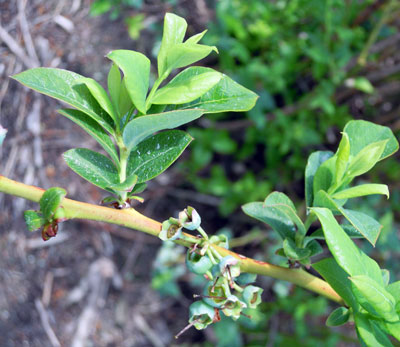
New shoot growth in ‘Bluecrop.’ Notice two new shoots on the
shoot to the left where two new shoots were formed after the tip
of the shoot
was killed in an early freeze.
Blossom blights are not serious in many well-managed fields. Growers should control anthracnose at the green fruit stage. Many growers have applied sprays to control cherry fruitworm and cranberry fruitworm. For more scouting information, see the Blueberry Insect Scouting Report for May 14-20, 2012.
Strawberry bloom is ending in June bearing varieties and the largest fruit are coloring. Ripe fruit is being harvested from fields in southern strawberry plantings. General strawberry harvest should begin next week.
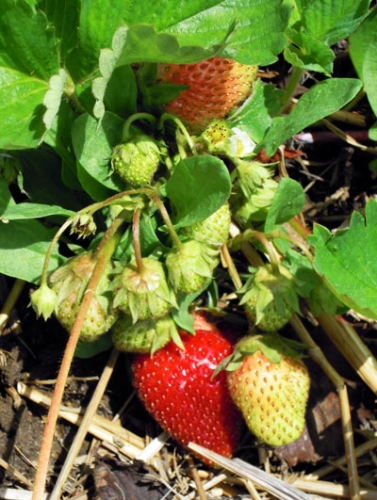
Ripening strawberries. Strawberry harvest should be
in full swing
next week.
Tarnished plant bugs are present and could cause cat facing of fruit. Both nymphs and adults feed, but nymphs cause the most damage. Common leafspot symptoms are showing up in some plantings.
In brambles, bloom is ending in raspberries. Early raspberry fruit is about a half-inch in diameter. Blackberries are blooming. Blackberries that suffered from earlier freezes are recovering. Damage is easier to see and assess with warmer temperatures this week.
Cranberries are at the jewel stage (pre-bloom) and some bloom is visible in ‘Stevens.’
Tree fruit
A few growers are reporting they have enough apples and peaches to need thinning. Deer browsing is occurring in young plantings. Insect numbers increased with last week’s heat. Insect trap numbers were up everywhere. Normally we would expect plum curculio egglaying activity to decline, but with scarce numbers of wild fruit in the woods due to frosts, egglaying activity in adjacent orchards is expected to continue.
Apricots are scarce. The few fruit are 1 to 1.25 inches in diameter.
Peach fruit are about an inch in diameter. Growers report misshapen fruit where one side is larger than the other. Oriental fruit moth catches increased last week, indicating the first flight has peaked. Flagging of terminal ends by burrowing larvae has been reported. Bacterial spot symptoms are showing up on leaves of susceptible varieties. Rusty spot, caused by the powdery mildew fungus, is common on fruit.
Sweet cherry fruit are about 18 to 22 mm in diameter and coloring. Birds are beginning to feed on ripening fruit. Many fruit are misshapen and the fruit surface is often pitted.
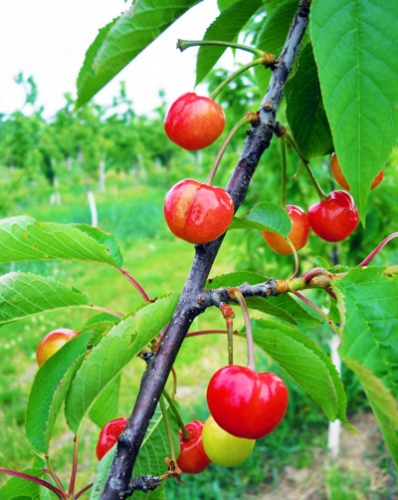
Coloring sweet cherries, the stem with no fruit at the top
indicates that birds are already eating the fruit.
Tart cherry fruit are about at 12 to 14 mm and pale green. Most fruit is found on trees at sites with good air drainage. Sunday night’s (May 20) rain was a cherry leaf spot infection period. Growers need to control this disease to maintain the health of their trees.
Plums are hard to find, but some growers report a light crop of ‘Shiro’ and ‘Methley’ Japanese plums. Protect against black knot as long as shoot growth continues. Leaf spotting and shot holes from bacterial infections are common.
Apple orchards on good sites have a light crop and some will need thinning. Apple fruits are 18 to 22 mm. Misshapen and russeted fruit is common. Growers should check their orchards for apple scab symptoms. Very few ascospores were caught in the rain this past weekend, indicating we are near the end of the primary apple scab season.
Codling moth trap catches rose sharply at some locations. Codling moth biofix was set as May 7. Obliquebanded leafroller adults were caught last week. Fire blight symptoms can be found in a few orchards, including young sites with no history of this disease. A year like this with no diseases is an excellent time to prune fire blight out.
Pear fruit continues to grow in spite of low seed numbers. Primary scab season is nearly over – growers should check their blocks to see if secondary scab symptoms are present. Pear psylla is present in low numbers.
Upcoming meetings
There is no Monday fruit meeting on Memorial Day (May 28). Our next Monday fruit meetings will be June 4 at Fruit Acres Farms at 5 p.m. Fruit Acres is located on the northeast corner of Friday and Carmody Roads about 1.5 miles south of the Coloma Exit on I-94. One RUP credit is available at the meeting.
There is a grape meeting Tuesday, May 23, from 6 to 8:30 p.m. at Cronenwett Farms, 70121 28th St., Lawton, Mich. (see directions). The $15 registration fee includes supper and 2 RUP credits. Topics to be covered include weed control comparison plots, current insect and disease control considerations for reduced crops and canopy management adjustments for reduced or no crop situations. Please RSVP to the Berrien County Extension office in advance (1-269-944-4126) if you plan to attend so we can have accurate counts for supper. On-site registration will be available, but please let us know if you plan to attend.
Southeast Michigan – Bob Tritten, Michigan State University Extension
|
Weather
Tree fruit growers are finding a few isolated fruit on a few varieties, but most are not finding enough fruit to continue pest control operations for the season. Growers continue to sort out strategies to replace income losses for the year and to seek fruit from other growing regions. As I indicated in my last two reports (see the May 15 report and the May 8 report), there has been a significant crop loss in all tree fruits across the region.
Fruit farms in the southern tier of Michigan counties still have some viable tree fruit crops as well as a few fruit farms located very close to Romeo, Mich. The extent of crops in these areas is still being sorted out; it appears that southern counties have just over half of an apple crop and even fewer peaches. In apples, I look for June drop to begin later this week – at least two weeks ahead of normal. So even in the few regions with a crop, a bit more time is needed to sort out the effects of our spring freezes.
Our blueberry crop is thinning out for several varieties, most notably Blueray. Most varieties are at petal fall to early fruit set, so it is too early to tell for sure what fruit will remain. Strawberry harvest will begin over the weekend for a few farms in Monroe and Lenawee counties, well over a week ahead of normal harvest.
Our early, warm season is still running about two weeks ahead of normal in terms of growth stages, and even more than that in terms of degree day totals.
Most of the region received one or two rain events over the past week. However, we received very little measurable rain over this same time, with most farms receiving only a few tenths of an inch of rain. Our soils are now starting to become dry. Newly planted fruit crops have put on a fair amount of new growth in the past two weeks.
|
East Michigan Growing Degree Day Totals for March 1 to May 21 | |||
|
Location |
GDD42 |
GDD45 |
GDD50 |
|
876 |
709 |
472 | |
|
836 |
676 |
449 | |
|
Flint (Genesee) |
919 |
749 |
512 |
|
908 |
745 |
509 | |
|
970 |
796 |
542 | |
|
784 |
628 |
415 | |
|
875 |
709 |
470 | |
Tree fruits
Apples were hard to find this week for me to check for fruit development. However, I was able to find just a few Empire that were 18 to 20 mm. Most apple trees have between 5 and 7 inches of new growth. The second Apogee application is expected to be made in the next week to try to contain new growth.
I continue to see a fair amount of newly opened apple blossoms in a few varieties in the last two weeks. These are tertiary (or third in order of king and side bloom being first, then secondary bloom on 1-year-old wood) blossoms or what most growers refer to as “rag tag” bloom. While some of these blossoms may make it to harvest, they will be very poor quality fruit, and the low number of these fruit are not economical to control pests for the remainder of the season.
Overall, insect pressure has been low over the past week, with the exception of codling moth. Codling moth adult trap catches have been high at most farms the past two weeks, with trap catches at most farms being in the range of 20 to 30 moths per trap. I set the regional biofix date of May 10. With just a few warm nights so far this season when mating can occur for codling moth, I am suggesting that growers with an apple crop can delay their first insecticide application for its control for several days in order to reduce their costs.
Plum curculio fruit stinging is now being seen. Mullen bug adults have been found in a few apple blocks, but I believe that they are now predators. Oriental fruit moth trap catch remains low as first generation adult flight has ended. I set a regional biofix for oriental fruit moth of April 19. A few tarnished plant bugs are being seen in apples and other tree fruit. Rosy apple aphid leaf curling has become much more evident in the past week, with good numbers of predators feeding on them. Wooly apple aphid populations are starting to build. I continue to see a few other aphid species, including apple grain and green apple aphids.
European red mite egg hatch is continuing. Two spotted spider mite adults are being seen in low numbers, with egglaying occurring already. Predators are being found in good numbers for this time of the season; including green and brown lacewing adults, solider bugs, minute pirate beetles, ladybird beetles, Stethorus beetles and A. fallacis mites.
We continue to catch apple scab spores at both of our monitoring stations with the wetting event of last night (May 21), with the number of spores declining with each rain event. Most of our weather stations have not had an apple scab infection period in the past week, with the exception of Commerce Township, Mich. Growers will need to continue apple scab control until the end of primary apple scab season, even if they have no crop. I am now seeing both leaf and fruit scab in only a few orchards. The apple scab maturity model is predicting that all apple scab spores are now mature, but we need more moisture for them to be released. Depending on rainfall, I expect the end of primary apple season to occur in the next week or so. I saw a few fire blight strikes in the past few days.
Powdery mildew-infected terminal barches are becoming much easier to find. Frog eye or black rot leaf symptoms are being seen in several apple blocks.
Pears have dropped all of their fruitlets in most blocks, with the exception of winter pears growing in the southern part of our region. Pear psylla adults continue to fly, with heavy egg hatch particularly in the tops of trees. Pear psylla populations will need to be controlled where there is no crop this year.
Peaches have no viable fruit remaining at most farms and at others a very light crop in a few varieties. Oriental fruit moth trap catch is down. I set a regional biofix for oriental fruit moth of April 19. Green peach populations are now increasing. For trees with no crop, this year is a good opportunity to do some major pruning to reduce tree height. Be careful not to remove more than a quarter of the leaf surface.
Sweet and tart cherry fruit damage was extensive from the April 29 freeze event, with very little to no viable fruit remaining. Growers are now starting to find a few handfuls of sweet cherries. Cherry leaf spot disease needs to be controlled in blocks that do not have a crop and maybe cherry fruit fly in problem blocks.
Plums were severely damaged by the last freeze event. Most blocks have little to no viable fruit remaining.
Small fruits
Strawberries are at 10 percent of petals remaining to thimble-sized and larger fruit at most farms. Berries are coloring at farms in the southern part of the region. Berry harvest is expected to begin around May 25-28 in the south, May 30 to June 3 for farms north of Detroit and a few days later for farms in the Thumb. This will be the earliest that some farms have ever opened for harvest.
I continue see evidence of slugs moving about in strawberries. Growers need to do a good job of scouting for them. I have not seen any new strawberry clipper damage in the last week. The final gray mold fungicide application was made last week. No new angular leaf spot disease symptoms have been seen in the last week. Growers need to keep a close eye out for this disease and be ready to control it if the need arises.
Raspberry bloom is starting for summer fruiting types and new canes continue to emerge from the soil for fall bearing types. There is extensive tip burn or dieback from our freezes on summer fruiting types at many farms. Fall bearing raspberries are sending up a new set of canes where they were damaged from earlier freeze events, with fall raspberry canes being 8 inches in length.
Blueberries are at late petal fall to fruit set for most varieties, with some fruit drop in Blueray at several farms. Next week should tell the story if there was any freeze damage in blueberries. I am seeing a few low lying sites where there has been some freeze damage. Phomopsis canker-infected canes are now visible at many farms. Keep an eye out for mummy berry disease and Phomopsis canker in frost-protected blocks.
Grape flower clusters are nearly ready to open. Some canes that were damaged in the many freezes appear to have been killed. I would wait for a few more weeks to remove those canes, however, for any signs of emerging buds.
Grand Rapids Area Tree Fruit– Amy Irish Brown and Phil Schwallier, Michigan State University Extension
|
Crop update
For blocks with viable fruit, the physiological event known as “June drop” has not taken place yet in apples on the Ridge. This year, June drop might be better known as Memorial Day drop as it is expected at any time as we continue to be about three weeks ahead of average degree day totals. In blocks with viable fruit, chemical apple thinning should be done soon. Keep in mind that thinning ahead of a warming trend is recommended to get results from thinners. Many blocks in the Grand Rapids, Mich., area with viable apples need to only have the tops of trees thinned. Normally in reduced crop situations, it is likely that fruits will be more difficult to chemical thin. Since 2012 is not a normal year, please exercise caution with chemical thinners.
Fire blight update
The rains that moved through Sunday night (May 20) could have triggered a blossom blight infection for newly planted trees that came into bloom prior to Saturday afternoon (May 19). Blossom blight needs to stay on your radar screen for the upcoming predictions of temperatures over 80 degrees with chance of rains. Many newly planted trees have just started to come into bloom depending on planting date and that open bloom is susceptible to fire blight. Symptoms from the blossom blight infections the first week in May should be present now, but none has been reported yet. Cut out any infections as you see them.
Apple scab
Spore numbers have been in the single digits for several weeks now and with the latest rain on May 20, there were zero spores. This was a night rain, which often does not cause spores to release. However, given the crop stage and the degree day totals from green tip, it is very likely that primary scab is over for the Ridge area and possibly for Oceana and Mason counties as well. I will continue to check spore rods for one or two more rains.
Powdery mildew
Continue to monitor all blocks for mildew. The warm, humid weather from last weekend and in the forecast for this weekend will only enhance mildew infections. Until terminal bud set, mildew must be managed so as not to end up with high inoculum levels for 2013.
Tree fruit insects
For those blocks that have viable fruits, you should consider management of the following pests.
Plum curculio has been active for three weeks. No additional egglaying scars have been found in any tree fruits over the last week – even with the warmer weather last weekend. Monitoring should continue for another week or so, but in the Grand Rapids, Mich., area, activity appears to have declined. In blocks with enough fruit for harvesting, plum curculio management should continue as it is likely that damage could be more severe in light crop situations.
Codling moth. We have accumulated 184 DD50 since the May 3 biofix on the Ridge, indicating that egglaying is underway. For blocks with higher numbers of adult flight, management should be considered to keep populations from building which will lead to more issues for 2013. Even with little to no fruit, codling moth numbers could build if you let them. First generation eggs are laid on leaves and some fruits and anything you do to curb high numbers now will have a dramatic effect on second generation in high pressure blocks.
Oriental fruit moth. A regional biofix was set for oriental fruit moth on April 15 and we’ve accumulated 363 DD45 since then. This indicates peak egg hatch which needs to be managed for stone fruits to prevent shoot flagging, which will potentially reduce your fruiting wood potential for next year.
Borers. American plum borer and lesser peach tree borer flight have begun. Trunk sprays can be started in stone fruits now. Dogwood borer frass can be seen in M9 clonal rootstocks – no adult flight yet. Timing for Dogwood borer frass trunk sprays is at peak adult flight – usually around July 4, but expect it to begin earlier this year.
Grand Rapids Area Small Fruit– Carlos García-Salazar, Michigan State University Extension
|
In the Grand Rapids, Mich., area, crop phenology continues progressing as weather conditions over the past seven days have remained around the optimum for growth and development. Rains have been absent for the most part, allowing growers to conduct the required pest control activities without impediments. So far, the amount of rain accumulated during the past seven days amounts to less than 1 inch. Meanwhile, daily minimum and maximum temperatures in the region averaged 44 and 77°F, respectively. Regarding degree days, up until May 22 there are 520 DD base 50°F and 896 DD base 42°F accumulated since March 1.
Crop growth stages
Strawberries are in in full bloom and fruits in early varieties are coloring. Strawberry insect problems are related to tarnished plant bug (Lygus spp.). Meanwhile, raspberries started blooming and so far no problems are reported.
For blueberries, early varieties are in the green fruit stage (pea size) and Elliott is in petal fall. Blueberry fields north of Allegan County are showing a heavy fruit set, especially in the varieties Jersey and Elliott. Fruit set in the variety Bluecrop varies from field to field and in this variety we may see a 25 to 30 percent reduction in the size of the crop for 2012 due to poor pollination and frost problems. However, since Bluecrop represents only 27 percent of the harvest area, the overall impact of this reduction in the final Michigan blueberry crop might not be significant. Also, the blueberry fruit “June drop” has started in most early varieties and frost-damaged and non-pollinated fruits are falling off the bushes almost two weeks earlier than in 2011.
Currently, the most important problems in some fields are sparse foliage and diseases, mainly phomopsis caused by winter damage. The combination of a heavy fruit set and the light foliage will create some problems especially in varieties like Bluecrop and Duke. Fields that suffered extensive frost damage are showing multiple canes with abundant fruit, but fewer or no leaves at all. Fruits in those bushes will not reach maturity nor may produce a commercial crop. Those canes will not set buds for the next season and they may die at the end of the summer. Thus, it is recommended to mark those canes and remove them to allow new shoots to develop during the current season. The new growth will allow the bush to produce berries for the next year’s crop.
For small-bushed, 2- to 3-year olds severely affected by frost and cane diseases, the recommendation is the same: prune all dead and diseased growth to allow the new shoots to develop during the current season.
Regarding insect problems, cherry and cranberry fruitworm adults continue flying and according to the cranberry fruitworm phenology model, the egglaying period is in progress for both species. For those fields already in the green fruit stage, the application of the second spray against fruitworms is needed to prevent further fruitworm damage.
Northwest Michigan – Nikki Rothwell, Duke Elsner, Erin Lizotte, Michigan State University Extension
|
Weather report
The weather across the region has been very summer-like where daytime temperatures reached into the high 80s and even low 90s over the weekend. Growing degree days continue to accumulate, and with the recent warm temperatures, they have accumulated quickly over the last week. At this time, we have accumulated 755GDD base 42 and 400GDD base 50, and these accumulations are much higher than our average: 463GDD base 42 and 219GDD base 219.
We have received no rainfall in the last week, and it is extremely dry here in the north. Newly planted trees that have no irrigation are starting to wilt. Our light soils have really dried out in the past week, and we do not see moisture in soil above 8 to 10 inches in depth.
Crop report
Bloom has ended in all tree fruit crops except for some apple orchards in the far north, and fruit is starting to size. Fruit size is noticeably big for sweet and tart cherries, likely due to the small crop load throughout the orchard. Sweet cherries are already approaching 11 to 13 mm, and apples at the Northwest Michigan Horticultural Research Station (NWMHRS) are between 7.5 to 10 mm. There is still an apple crop in northwest Michigan, although it will be small. Growers are now moving into thinning mode, and those with a crop will need to thin with caution because king bloom in most orchards were damaged by the frost.
Pest report
Cherries. The dry weather continued over the last week, keeping the risk for cherry leaf spot infection low, but the symptoms from earlier infections are being reported. Unfortunately, the symptoms we are observing now came with the rains of two weeks ago. Growers need to be scouting their orchards for leaf spot. If leaf spot is visible, growers must be diligent about keeping the remainder of the leaves protected as we still have a long season ahead of us. Read Cherry leaf spot symptoms already observed in low crop orchards for more information on this topic.
Regardless of the crop load, growers should plan to continue managing for cherry leaf spot and powdery mildew. Early cover sprays – ideally at first cover timing – are critical to season-long powdery mildew management, so growers should consider a fungicide with a strobilurin (Pristine, Gem or Adament) because they are effective against both cherry leaf spot and powdery mildew. The sterol inhibitor fungicides (Indar, Elite, Orbit) are also effective powdery mildew materials, but will not be effective against leaf spot due to widespread resistance in all the major fruit producing areas of Michigan. Light crop loads this year will likely lead to significant shoot growth and increased succulent leaf area that is highly susceptible to powdery mildew.
Additionally, the Cherry Industry, Michigan State University, EPA,MDARD and Syngenta have worked together to obtain a 24(c) special local need registration (SLN) for use of Bravo Weather Stick (chlorothalonil) beyond shuck split. Traditional timing of chlorothalonil for cherry leaf spot has been prohibited past the shuck split timing prior to this newly registered use. With the 24(c), growers must follow a series of restrictions in order to use this product legally throughout the growing season to ensure that post-shuck split applications do not result in illegal residues.
Growers should be aware that cherries harvested 21 days after the last application of Bravo will have illegal residues, and to ensure the residues on the fruit are reduced to a legal level (less than 0.5 ppm), growers MUST carefully follow all label directions. The cooling pad procedures on the SLN label are key to reducing residues to a legal level. Illegal residues not only violate federal law, but they have serious consequences for growers, processors, and the Michigan tart cherry industry. Although a more permanent solution is underway for the 2012 season, growers should obtain the Training Affidavit by going to MDARD’s Cherry SLN webpage and complete Steps 2 and 3.
MSU Extension will be available to help growers work through this educational step to be able to use chlorothalonil beyond shuck split by using the MDARD website. Growers with questions or those in need of assistance can call the Northwest Michigan Horticultural Research Station at 231-946-1510. However, if orchards have no crop and will not be harvested in 2012, chlorothalonil can be used as the label states for non-bearing orchards. This distinction needs to be clear—to harvest or not to harvest—to comply with the 24 (c) label for 2012. Additionally, this special label is for Bravo Weather Stick only and will not apply to other products containing chlorothalonil.
The symptoms of bacterial canker remain prevalent on sweet cherries around the north; canker has also been reported in tart cherries. Bacteria can survive in the bark, cankers and systemically within trees that have been previously infected. This spring conditions were favorable for bacterial canker (prolonged periods of cold, frosty, wet weather) and allowed the bacteria to multiply within the overwintering sites and be disseminated by rain. Freeze and frost damage caused by the weather allowed for an easy entry point and infection. Unfortunately, there is no effective treatment for bacterial canker at this time. Dormant copper applications are the traditional treatment for bacterial canker, but even this treatment has had marginal impact on bacterial canker wood infections.
American plum borer adult flight continued this week with trap counts indicating that we had likely reached peak adult emergence for first generation at NWMHRS last week. Peak adult emergence is the critical control period for American plum borers and trunk applications of Lorsban remain the recommended strategy. Additionally, there was a large emergence of lesser peach tree borers this week with an average of 29 moths per trap, slightly higher than the highest trap catch in 2011. These lesser peach tree borer trap catches indicate that we are at the beginning of peak emergence in that species. Lorsban trunk applications are also recommended for lesser peach tree borers; growers who applied Lorsban for American plum borers should keep in mind that trunk applications should be applied at least two weeks apart. The Lorsban labels vary between products, so growers should read and follow the label carefully to ensure proper use.
Growers should be scouting for obliquebanded leafroller larvae as leaves continue to expand; we have observed a few larvae in terminals at the station and at obliquebanded leafroller trials throughout the state. Growers can scout their orchards by examining 20 clusters per tree in five trees per orchard for larvae or feeding sites. An insecticide should be applied if they observe more than two larvae or feeding sites per tree. The materials that target the larval stage of obliquebanded leafroller include Delegate, Belt, Altacor, Voliam flexi, Entrust and Bts. Growers in northwest Michigan should not expect organophosphates or pyrethroids to provide effective control of obliquebanded leafrollers because of insecticide resistance. Black cherry aphids are visible on isolated sweet cherry trees.
Plum curculio activity has increased visibly this week with adults migrating into orchards from overwintering sites and fresh, crescent-shaped egglaying scars visible on green fruit. Many of the non-organophosphate insecticides (pyrethroids, neonicitinoids and oxadiazines) for plum curculio management require treatment to begin around petal fall to provide adequate control. TheMSU Tart Cherry Postponed Insecticide Treatment Strategy (P.I.T.S.) model for the control of plum curculio is estimating the accumulation of 211 degree days since tart cherry biofix (full bloom April 20 at the NWMHRS) control is not recommended until 375 GDD from the biofix date, leaving plenty of time before treatment. The MSU P.I.T.S. model should only be used in carefully scouted orchards. If growers have a short crop that they plan to harvest this year, increased competition for those fruit as egglaying sites will warrant earlier plum curculio control to protect the remaining fruit. Growers who have no harvestable crop may consider reducing their plum curculio management as the issue of internal larvae in the fruit at harvest is not of concern. Refer to the E-154 2012 Michigan Fruit Management Guide for more information on plum curculio management materials.
Apples. The cool, dry weather last week led to a low risk of scab infection occurring, but unfortunately it also means we cannot call an end to primary scab. Based on a March 20 biofix (McIntosh green tip), the Enviro-weather apple scab model is estimating that 80-plus percent of primary scab spores have been discharged around the region, and 100 percent are mature and ready to be discharged in upcoming rain events. EBDCs and Captan are both excellent scab protectants, and provide five to six days of protectant activity when used at full rates. Growers should remember that spray intervals should be tighter when relying on these materials. Keep in mind that EBDCs have a 77-day PHI, so they are best used early in the growing season. Growers should also note that strobilurin resistance has been confirmed in all major apple growing regions of the state and the mutation confers complete resistance – fungicides containing strobilurins will not work against apple scab and increasing the rate of a strobilurin is not an effective option.
Regardless of crop load, growers should carefully consider their scab management program as inoculum can build quickly over a season and make control difficult in subsequent seasons. If growers are approaching their season-long limits for EBDC applications, there are a number of alternatives. Refer to the E-154 2012 Michigan Fruit Management Guide for more options.
In orchards where bloom remains, fire blight is a concern and keeping an eye on the weather and the fire blight model remains important. The warm weather has caused the epiphytic infection potential (EIP) to climb well over 200 in many areas. When the EIP reaches 100 (or is forecasted to do so), the average temperature is greater than or equal to 60°F, and rain or trauma (high winds or hail) that occurs there is a high potential for infection. For now, the forecast is not predicting rain. At this time, streptomycin remains the bactericide of choice for controlling fire blight in the northwest. However, many growers are considering a 1:1 tank-mix of oxytetracycline materials (FireLine or Mycoshield) and streptomycin due to streptomycin resistance concerns (at a 1lb rate of each material).
Growers located in Grand Traverse County that believe they have streptomycin resistance can apply Kasumin during bloom for fire blight control. EPA has granted a Section 18 Specific Exemption for the use of Kasumin 2L (kasugamycin) for the control of the blossom blight phase of fire blight in 2012. This use is for orchards where streptomycin-resistant fire blight bacteria are present. The Section 18 is applicable to Berrien, Cass, Grand Traverse, Ionia, Kent, Montcalm, Newaygo, Oceana, Ottawa, and Van Buren counties. This Section 18 exemption only applies to counties where we have detected streptomycin-resistant isolates of the fire blight pathogen Erwinia amylovora. Read MSU’s George Sundin’s article Kasumin has been granted a Section 18 Specific Exemption for fire blight control for 2012 for more information.
The next most important fire blight control measure is to use Apogee (prohexadione calcium) for shoot blight management. Apogee is a growth inhibitor that provides excellent control of shoot blight. The first timing for an Apogee spray is at king bloom petal fall. Apogee is shoot specific, meaning the effect is only observed if the shoot is covered; thus, excellent coverage is essential. The “Apogee effect” on fire blight begins approximately 10 to 14 days after application. Growers who used Apogee last season are encouraged to continue with treatments this year as the removal of Apogee from the system combined with light crop loads could lead to excessive vegetative growth.
Eight codling moths were trapped at the station this past week, setting the biofix at the station as May 14 based on initial emergence. We accumulated degree days quickly with the hot weather over the weekend leading to the accumulation of 111 DD50 as of May 22. Growers can track the progress on their farms using the Enviro-weather codling moth model. The codling moth model is designed to help growers accurately apply insecticides at the recommended treatment timings which range from 100 to 250 DD50 post-biofix, depending on pest pressure and insecticide mode of action. Ovicidal insecticides are positioned early to coincide with first generation egglaying (100 DD50), followed by larvicides (250 DD50) which are targeted at first generation egg hatch.
The adults we are currently catching are primarily mating during a four-hour period beginning around dusk. Cool temperatures, wind and rain greatly limit codling moth flight during this critical period with male activity dropping quickly if temperatures fall below 60°F, so growers should be confident that low catches are accurately assessing codling moth activity. The positive effects of this slowed activity is compounded as female fecundity (ability to reproduce) decreases by approximately 25 percent for every 24 hours a codling moth female is delayed from mating after she has emerged from her cocoon. Based on the unusual patterns of emergence we have observed in other pests this season, growers should be carefully monitoring for codling moth and weighing the pros and cons of treatment in no crop situations. There are a number of effective codling moth materials. Refer to the E-154 2012 Michigan Fruit Management Guide for more information.
Growers should be on the lookout for obliquebanded leafroller larvae feeding on blossom parts. Spotted tentiform leafminer adults continue to emerge in growing numbers. Oriental fruit moths continued to emerge with an average of 33 moths per trap.
Grapes. Vineyards are looking very nice now as recent, warm weather has promoted rapid shoot growth.
Adult potato leafhoppers were seen in very low numbers in a few Old Mission vineyards on May 21. On wild vines in woodlots, adults of the three-banded leafhopper are quite active, causing stippling injury to leaves. This species usually does not cause any injury to vinifera or hybrid cultivars; it prefers cultivars with leaves that have relatively hairy lower surfaces. The larvae of grape plume moth are numerous on wild vines. They tie together terminal leaves (and clusters at this stage of growth) with silk and feed inside the webbing. This species is another species that rarely reaches significant numbers on cultivated vines, but growers should be looking for them in areas nearest wild vines.
No powdery mildew infections have been reported, but we are in the period when initial leaf infections are possible. Ascospores of this disease are typically released from over-wintering structures during rains of at least 0.1 inches if the temperatures are over 50 degrees between bud break and fruit set. Our droughty conditions have really limited the potential for powdery mildew so far.
Saskatoons. It looks like saskatoons faired pretty well despite the odd spring weather. Berry set is complete at all sites and there appears to be a good crop. No significant insect pests have been active at the sites I monitor. There is a bit of Entomosporium leaf spot in many sites; I suspect cold injury to leaves may have served as a predisposing agent to infection. This disease may become a major concern if we get into a period of rainy weather.



 Print
Print Email
Email